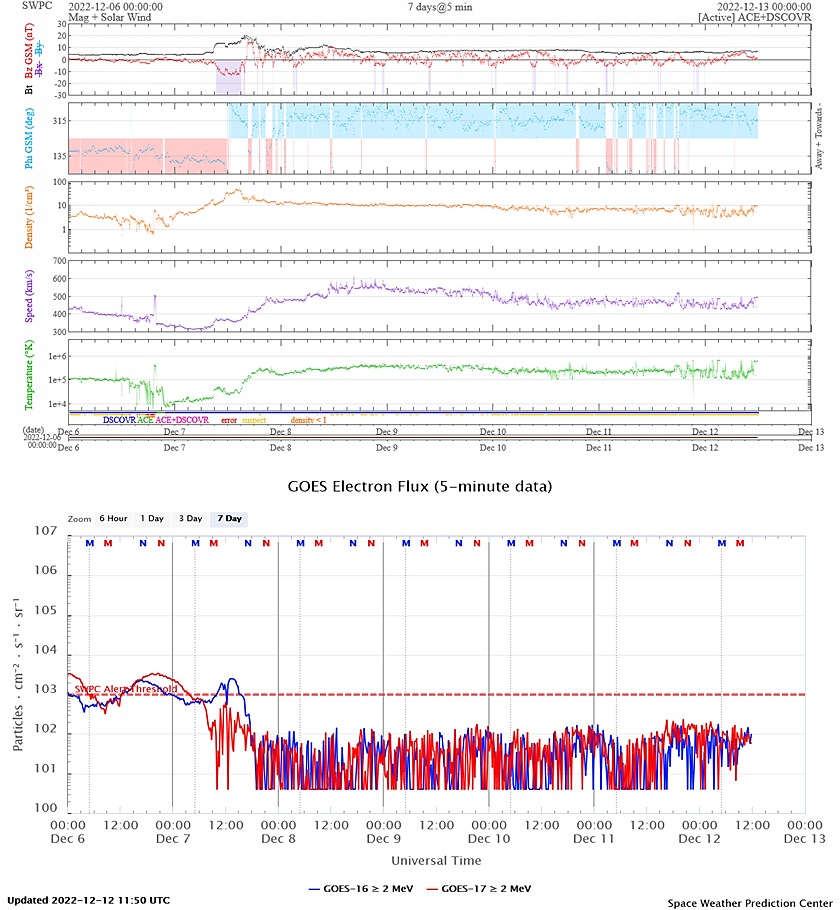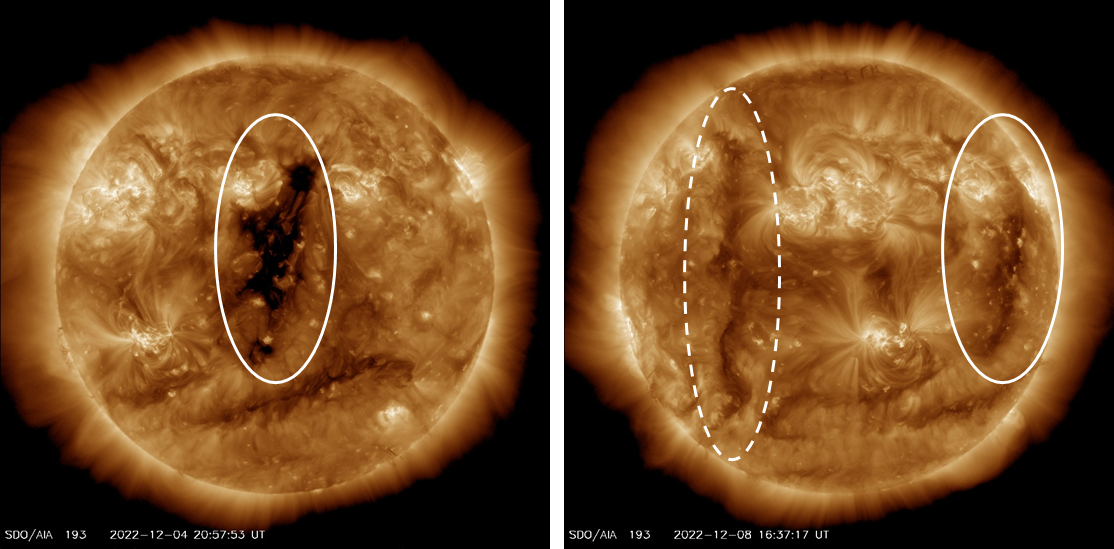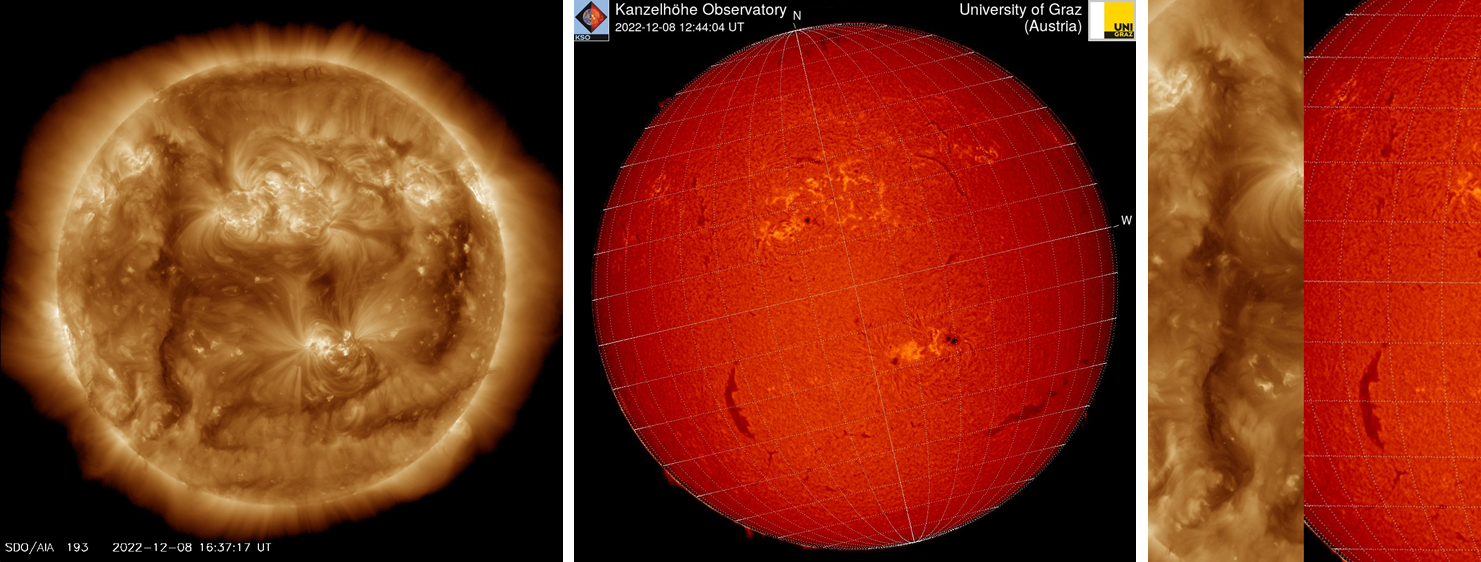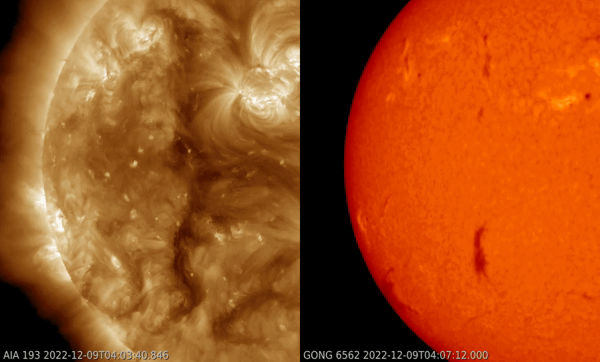Coronal holes are regions in the hot solar atmosphere ("corona") where the plasma density at that temperature is very low compared to its surroundings, and thus they look like dark shapes in the corona. Linked to unipolar, open magnetic fields stretching into space, they are the source of the high-speed solar wind which can create geomagnetic disturbances. Such a high speed stream from an equatorial coronal hole impacted the earth environment on 7 December, with the solar wind speed gradually increasing to values around 550 km/s (purple curve in the DSCOVR graph of solar wind data underneath). The wind speed didn't stay long above the critical value of about 500 km/s -barely a day-, which is probably why -so far- there has not been a significant rise in the greater than 2 MeV electron flux (GOES graph underneath). More on these highly energetic electrons is at the STCE's SWx Classification page and in this STCE newsitem.

The coronal hole responsible for the recorded high speed stream crossed the central meridian of the Sun (the "north-south" line) on 4 December, and was already approaching the solar west limb by 8 December as indicated on the extreme ultraviolet (EUV) images underneath (SDO/AIA 193). A new coronal hole located in the eastern solar hemisphere, as indicated by the dashed lines, seemed to ready itself to cross the central meridian a few days later. At first sight, it looked like a smaller and more stretched version of the previous coronal hole. However, a closer examination of the EUV images as well as of images made by Hydrogen-alpha filters (656.3 nm; Kanzelhöhe Observatory) revealed that this was not a coronal hole.

The feature highlighted by the dashed white ellipse in the image above is called a filament channel. A filament channel corresponds to a plasma volume where the magnetic field is primarily aligned with the polarity inversion line (PIL), i.e. the line separating areas of opposite magnetic polarity. The key feature of a filament channel is that it is a region of dominant horizontal field (not vertical or "incoming/outgoing") where the field on either side of the PIL points in the same direction. Filament channels are the unique sites of filament formation. Solar filaments are clouds of charged particles ("plasma") above the solar surface squeezed between magnetic regions of opposite polarity. Being cooler and denser than the plasma underneath and their surroundings, they appear as dark lines when seen on the solar disk and as bright blobs when seen near the solar limb (then they are called "prominences").
Channels are more fundamental than the filaments that form within them, as not every channel contains a filament and a single channel may survive a succession of filament formations and eruptions. The darkish hue of these filament channels is due to absorption of EUV lines in cool plasma condensations that are not observed in Hydrogen-alpha. Underneath is a side-by-side comparison in EUV and in H-alpha, showing the structure on 8 December, clearly indicating the presence of a filament, and thus that this structure was not a coronal hole and that there was no high speed stream en route to Earth. The full disk images also show some other filament channels (containing filaments) in particular near the north solar pole and in the southwest solar quadrant.

The filament restructured itself during the early morning hours (between 04 and 10UTC) of 9 December, completely disappearing in H-alpha. The EUV imagery in the clip is from SDO/AIA 193, while the H-alpha images are from the GONG network. The cadence in EUV is one image every 3 minutes, in H-alpha it is one image every 11 minutes. The "eruption" was not associated with a coronal mass ejection. The filament channel was not destroyed by this event, and gradually started to fill itself again during the subsequent days (11 December).

Some additional information on filament channels can be found in Li et al. (2022), Mackay et al. (2010), and Aulanier et al. (2002).





